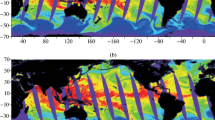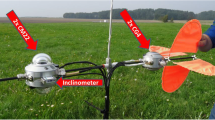Summary
Radiative divergence in the atmosphere was measured during 1964 at Point Barrow, Alaska, at a location 2.5 km inland from the Arctic Ocean. C. S. I. R. O.-radiometers were used in the two observational techniques employed: 1) A radiometer was mounted on the vertically traveling boom of a specially designed tower, measurements being taken at 1, 2, 3, 4 and 5 m, and 2) A gimbalized radiometer was suspended from a moored «kytoon», measurements being taken at levels up to 250 m.
Tower data comprise approximately 80 hours of observations over snow-covered tundra, in the temperature range of −4 to −30° C. Kytoon data comprise observations of six flights of 2 to 3 hours duration, all but one being over grassy tundra, in the temperature range of −5 to 5° C.
The sign of the measured divergence was usually negative, and the maximum convergences occurred during clear, calm weather, and in the lowest layers. The absolute magnitude of calculated divergences (Funk's method) was consistently less than that of the measured values. More accurate temperature and humidity measurements are necessary to explain the poor agreement of calculated and measured radiative divergences.
Zusammenfassung
Es wird über Messungen der Strahlungsstromdivergenz an einer Station 2,5 km landeinwärts von der Küste des Arktischen Ozeans in der Nähe von Point Barrow (Alaska) berichtet. C. S. I. R. O.-Strahlungsbilanzmesser wurden in zweierlei Weise verwendet: 1. Der Bilanzmesser wurde an einem speziell konstruierten Turm auf einem vertikal beweglichen Arm montiert und ermöglichte Messungen der Strahlungsbilanz in 1, 2, 3, 4 und 5 m Höhe über dem Boden. 2. Der Bilanzmesser wurde in kardanischer Aufhängung an einem Fesselballon befestigt und gestattete Messungen bis zu einer Höhe von 250 m. Die Beobachtungen in Bodennähe umfassen etwa 80 Stunden, bei Lufttemperaturen zwischen −4 und −30° C. Die Ballondaten umfassen 6 Aufstiege von je 2 bis 3 Stunden Dauer, bei Lufttemperaturen zwischen −5 und 5° C.
Das Vorzeichen der beobachteten Strahlungsstromdivergenz war gewöhnlich negativ. Die größten Konvergenzen traten bei windstillem, heiterem Wetter in der untersten Luftschicht auf. Der Betrag der nach der Methode vonFunk berechneten Divergenzen war durchwegs kleiner als der der gemessenen. Diese Diskrepanz ist vermutlich durch die relativ ungenaue Kenntnis des Luftfeuchtigkeitsprofils und der Strahlungstemperatur der Schneeoberfläche zu erklären.
Résumé
On rapporte ici sur des mesures de la divergence du courant de rayonnement, mesures effectuées à une station située à l'intérieur des terres à 2,5 km de la côte de l'Océan Arctique au voisinage de Point Barrow (Alaska). On a utilisé le bilanmètre de rayonnement C.S.I.R.O. de deux façons différentes: 1) L'appareil était fixé à un bras se mouvant verticalement le long d'une tour spéciale; ce montage a permis des mesures du bilan de rayonnement à 1, 2, 3, 4 et 5 m de hauteur sur sol. 2) L'appareil fut accroché à un ballon captif au moyen d'une suspension à la cardan; ceci a permis des mesures jusqu'à 250 m de hauteur. Les observations faites au voisinage du sol couvrent environ 80 heures par des températures situées entre −4 et −30° C. Les relevés effectués par ballon représentent 6 ascensions de 2 à 3 heures chacune par des températures entre −5 et +5° C.
Le signe des bilans mesurés était en général négatif. Les convergences les plus importantes eurent lieu par temps calme et clair et dans les plus basses couches de l'atmosphère. Les grandeurs des divergences calculées selon la méthode deFunk furent sans exception plus petites que celles qui furent mesurées. On peut expliquer ces différences par le fait que les profils de l'humidité de l'air ainsi que la température rayonnante de la surface de la neige étaient relativement mal connus.
Similar content being viewed by others
References
Brooks, D. L.: A Tabular Method for the Computation of Temperature Change by Infra-red Radiation in the Free Atmosphere. J. Meteorol.7, 313–321 (1950).
Deacon, E. L.: Radiative Heat Transfer in the Air Near the Ground. Australian J. Scientific Res., Ser. A,3, 274–283 (1950).
Elsasser, W. M., andM. F. Culbertson: Atmospheric Radiation Tables. Meteorol. Monographs4, 23 (1960).
Elsasser, W. M.: Heat Transfer by Infra-red Radiation in the Atmosphere. Harvard Meteorol. Study6, 1–107 (1942).
Fleagle, R. G.: A Theory of Fog Formation. Journal Marine Res.12, 43–50 (1953).
Funk, J. P.: Improved Polythene-Shielded Net Radiometer. Journal Scientific Instruments36, 267–270 (1959).
Funk, J. P.: Measured Radiative Flux Divergence Near the Ground at Night. Quart. J. Roy. Meteorol. Soc.86, 382–389 (1960).
Funk, J. P.: A Numerical Method for the Computation of the Radiative Flux Divergence Near the Ground. J. Meteorol.18, 388–392 (1961).
Kelley, J., Jr.: An Analysis of Carbon Dioxide in the Arctic Atmosphere at Point Barrow, Alaska. University of Washington, Technical Report ONR 477 (24) (NR 307-252), 1964.
Koshelenko, I. V.: An Outline of the Formation of Low Clouds and Fog Owing to Radiational Cooling. Ukrainskii Nauchno-issledovatel'skii Institut: Trudy21, 16–22 (1960).
Author information
Authors and Affiliations
Additional information
With 4 Figures
Contribution 124, Department of Atmospheric Sciences, University of Washington, Seattle.
Rights and permissions
About this article
Cite this article
Lieske, B.J., Stroschein, L.A. Measurements of radiative flux divergence in the Arctic. Arch. Met. Geoph. Biokl. B. 15, 67–81 (1967). https://doi.org/10.1007/BF02319112
Received:
Issue Date:
DOI: https://doi.org/10.1007/BF02319112




